My thanks to Sherri Greene Ottis for allowing me to reproduce the following map, “Major Escape Routes Through France, 1940-1945.” from her book, Silent Heroes, Downed Airmen and the French Underground, Lexington, Kentucky: The University Press of Kentucky, 2001. The map was designed by John Hollingsworth. Although there were other escape routes, these certainly were some of the most important. To enlarge it and make it more readable, click once on the map and then once again.
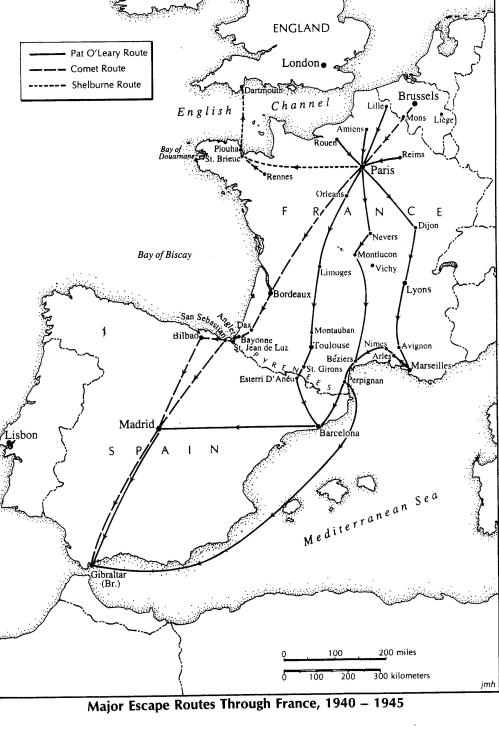 A similar map was prepared by the National Museum of the US Air Force, which has kindly allowed me to reproduce it below. To enlarge it significantly and make it more readable, click once on the map and then click a second time.
A similar map was prepared by the National Museum of the US Air Force, which has kindly allowed me to reproduce it below. To enlarge it significantly and make it more readable, click once on the map and then click a second time.
Both of above maps appear to have been inspired by a map, “Main evasion routes in western Europe,” that was published on p. 64 of the book M.I.9 Escape and Evasion 1939-1945, by M.R.D. Foote and J.M. Langley, Boston: Little, Brown and Co., 1979, 1980. That map can be viewed at http://airforceescape.org/escape-route-maps/. In addition, a map of the Comet Line escape route can be viewed at the Le Reseau Comete website at http://www.cometeline.org/ . On that website scroll down to view the map.
The following map was published in the June 2007 issue of the Air Forces Escape and Evasion Society newsletter, Communications, No source was given. Nevertheless, it gives some idea of the complexity of the different escape routes.
Belgian Ministry of National Defense Escape Line Map
The following map appeared on pg. 213 of the book Livre D’Or de la Resistance Belge, Ouvrage publié par la Commission de lè Historique de la Résistance instituée par le Ministère de la Défense Nationale. Publication date was sometime after the end of WWII.
Dutch-Paris Line
The map below of the Dutch-Paris Line escape routes appears in the following book: Megan Koreman, Gewone helden: de Dutch-Paris ontsnappingslijn 1942-1945, Amsterdam: Boom Uitgevers, 2016, and in an English translation, The Escape Line, How the Ordinary Heroes of Dutch-Paris Resisted the Nazi Occupation of Western Europe, Oxford University Press, 2018. It is copyrighted and may not be duplicated without permission of the publisher. It is reproduced here with the kind permission of the author and publisher.

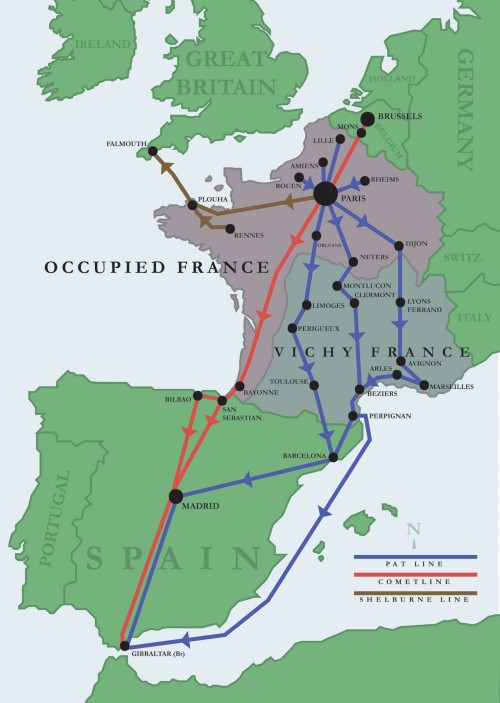
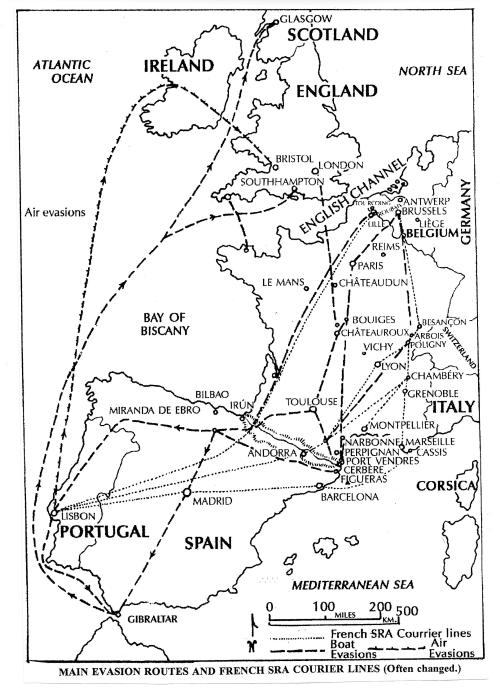
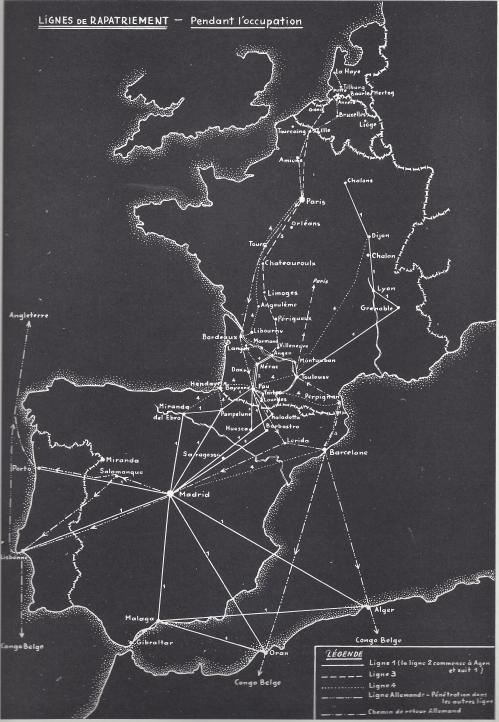
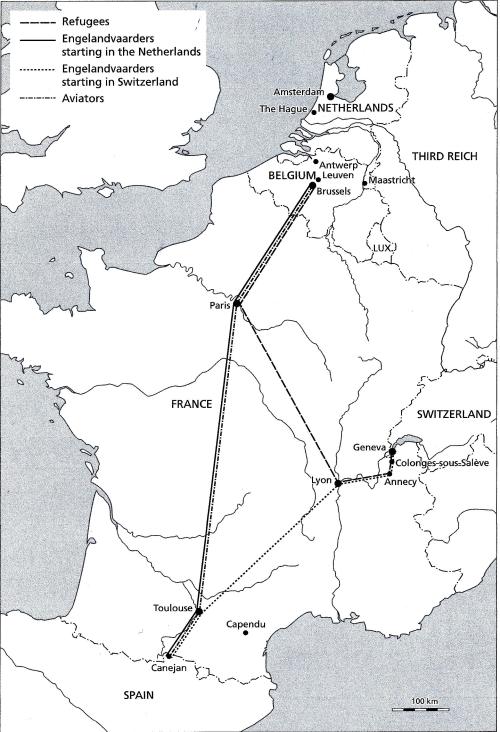
my dad went toulouse. pau. mauleon. orbizteta. i belrive from dads soe file it was called the greyhound line.
Hi I am trying to get my grandfathers soe file how can’t be done?
My dad went Cernay en Dormois (December 30, 1943), Paris, Toulouse, Tarbes, Campan, Artiques, Fabian to Bielsa, Spain (March 22, 1944), Zaragoza, Madrid to Gibraltar. He spent 3 or so weeks in Alhama de Aragon, Spain for R&R.
Somewhere in an Eric Maria Remarque novel, perhaps The Night In Lisbon, there is mention of an escape route called the “red road” or the “rose road” or “red highway” or something similar. Do you recall the corretct name? From your maps, it seems the Comet Route is very close to what I remember from my reading.
Regards,
Jack Worthington
Unfortunately I am not familiar with any of the names. However, it would seem likely that rail lines, mountain passes, etc. would pretty much dictate what route would be followed and that for that reason it would be similar to the Comet Line. You might want to contact Roger Stanton of the WWII Escape Lines Memorial Society at http://www.ww2escapelines.co.uk/. He might be able to help you.
Bruce Bolinger
I finally located the reference. The Night In Lisbon, p.178 paperback by Remarque. The terminology was Via Dolorosa. Not sure if this was poetic liberty for Remarque or if the name was actually used.
Please can you shed any light on the John Carter line which operated from Lyon 1942 until Jan 44? It went via Perpignan, to Blanes then to Barcelona?
Jan
Jangleaves1@gmail.com
When was the first escape over the Pyrenees?
The first escape over the Pyrenees by the Comet Line, probably the best known escape line, was in July 1941 (see Wikipedia article at https://en.wikipedia.org/wiki/Comet_Line). But there may well have been other crossings even earlier. Megan Koreman’s book “The Escape Line” describes the Dutch-Paris Line. A quick review of it indicates that it began operations in 1942. A website on the PAT Line (http://www.christopherlong.co.uk/pri/secpap.html) refers to that line having a firmly established operation by mid-1941. My guess is that escapees not associated with organized escape lines began crossing in 1940. I suggest you take a look at my list of escape and evasion books at this location on my website: https://wwii-netherlands-escape-lines.com/library/escape-and-evasion/. Some of them may help answer your question.
Best wishes,
Bruce Bolinger
Can anyone help? I need to find the escape route by Eugene Bullard from Paris to Spain.
What sources have you used in your research? I checked the Member Database of the Air Forces Escape and Evasion Society (https://airforceescape.org/afees-member-stories/), the AFEES Index to Evaders (https://airforceescape.org/newsletters/index-to-newsletters/index-to-airmen/ ), the Evasion Comete website (https://www.evasioncomete.be/aFichesChoix.html), the Library of Congress Veterans’ History Project (https://memory.loc.gov/diglib/vhp/html/search/search.html), and the National Archives Escape and Evasion Reports (https://catalog.archives.gov/search?q=*:*&f.ancestorNaIds=305270&sort=naIdSort%20asc) but did not find him listed. Variations in how his name was spelled may have prevented me from finding his name.
Bruce Bolinger
Webmaster